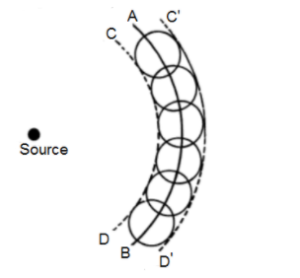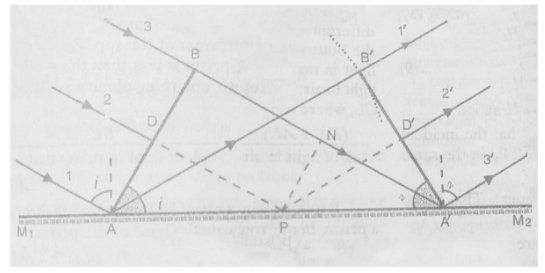Reflection
The rapid change in the propagation direction of a wave that reaches the boundary between two mediums is known as reflection. At least a portion of the approaching wave disturbance is contained within the same medium.
Types of Reflection
The different types of reflection are as follows:
- Regular reflection: A regular reflection is one that is clear and sharp, similar to the ones you see in a mirror. A mirror is a piece of glass with a uniform layer of a highly reflecting material, such as powder, applied to it. This reflecting surface consistently reflects approximately all of the light that strikes it. The angles of reflection between various points are not very different. As a result, the haziness and blurring are virtually completely gone.
- Diffused reflection: Other than mirrors, reflective surfaces have a rough polish in general. This could be due to surface wear and tear, such as scratches and dents or grime. Even the type of material used to create the surface can make a difference. All of this results in a reduction in the brightness and quality of the reflection.
When comparing angles of reflection between spots on such uneven surfaces, the angle of reflection is completely random. When rays strike a rough surface at slightly different spots, they are reflected in completely opposite directions. This is known as diffused reflection and it is what allows us to perceive non-shiny objects.
3.Multiple reflection: When an object is placed in front of a mirror, it creates a single picture. When we use two mirrors, A single source of light can be reflected several times because reflective surfaces like mirrors are very good at retaining the intensity of light in a reflection. This multiple reflection is feasible until the light intensity is so low that we can no longer detect it. As a result, we can have an almost unlimited number of multiple reflections. Every unique reflection also reflects an image. This means that each image is a result of an image or another image.
The angle between the two mirrors has a big impact on the number of images we view. We can observe that as the angle between the mirrors is reduced, the number of pictures increases. The number of pictures reaches unlimited when the angle is zero, i.e., when the mirrors are parallel to each other.

Wavefront
A wavefront is the location of all points that are in the same phase. Wavefronts are of three types. They are as follows:
- Spherical Wavefront: When a point source emits energy, the particles around it begin to oscillate, forming a spherical wavefront as the waves propagate in all directions.
- Planar Wavefront: If the source is infinite, the waves that emerge from it are parallel to each other (light rays coming from the sun are parallel to each other on earth). There is a creation of planar wavefront in such instances.
- Cylindrical Wavefront: If the light source is linear, a cylindrical wavefront is created. All of the points will be equidistant from the source and will be found on the cylinder’s surface.
Huygens Principle
Huygen first proposed that light moves in waves in 1678. After escaping from the light source, these waves travel at the speed of light in all directions. Huygen proposed a straight forward geometrical method for calculating the propagation of a wavefront.
According to the Huygens Principle-
- Every point on a wavefront generates new wavelets, which are referred to as secondary wavelets. Secondary wavelets have the same velocity as the primary wavefront and are equivalent to the speed of light (c).
- At any instant, a tangent or envelope to the secondary wavelets in the forward direction provides us the position of a secondary wavefront.
- The wavefront in a homogeneous material is always normal to the wave propagation direction.
Explanation of Huygens Principle

Let AB denote a segment of the wavefront at any given time ‘t’. To find the wavefront at any time
t + Δt, perform these steps:
- Draw circles of radii vΔt at numerous spots on AB to depict the section of secondary spherical wavelets, where the wave’s speed in a particular medium.
- Draw a common tangent CD and C’D’, which represent the wavelet envelope sections.
- CD is the forward envelope and gives the new wavefront if the source is to the left. If the source is to the right, the new wavefront is C’D’ (curvature will also be opposite). Kirchhoff mathematically explained the lack of back-waves or how wavefronts never travel towards the source but always away from it.
Laws of Reflection
According to the law of reflection:
- At the point of incidence, the incident ray, reflected ray and normal are all in the same plane. As a result, it must be demonstrated that the reflected ray is in the plane defined by the incident ray and the normal at the point of incidence.
- The angle of incidence and the angle of reflection () are always equal.
Laws of Reflection using Huygens Principle

Assume that AB is the plane wavefront incident on the plane mirror M1 M2 . Let ∠BAA’ = ∠i be the incident angle. The incident rays perpendicular to wavefront AB are 1, 2 and 3.
Every point on the wavefront AB, according to Huygens’ Principle, is a source of secondary wavelets. Assume secondary wavelets from point B arrive at location A’ in time t.
BA’ = c x t ……………………..(1)
c= velocity of light in vacuum
Assume secondary wavelets from point A arrive at point B’ in time t.
AB’ = c x t ………………………(2)
If you join A’ and B’, the reflected wavefront will be A’B’. The reflected rays perpendicular to A’B’ are 1′, 2′ and 3′. Also, let B’A’A = r be the reflection angle.
We have AA’B and AA’B’ from similar triangles.
BA’ = AB’ (From (1) and (2))
∠B = ∠B’ (Both are 90)
AA’ = AA’ (Common Base)
Hence, triangles are congruent.
∠i = ∠r
This is also known as Snell’s Law of reflection.
Conclusion
The phenomenon of light waves colliding with a surface and bouncing back is known as reflection. Huygens’ Principle is used to verify the laws of reflection. The incident ray, the reflected ray and normal to the surface at the point of incidence, all lie in the same plane. Angle of reflection equals angle of incidence. The Huygens Principle, proposed in 1690 by the Dutch mathematician, scientist and astronomer Christiaan Huygens, is a powerful tool for examining many optical phenomena.
 Profile
Profile Settings
Settings Refer your friends
Refer your friends Sign out
Sign out






